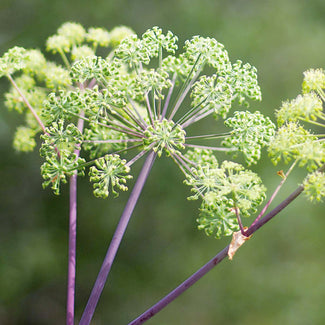
Season: Fall - Spring
Looking for a Specific Herb?
Search Our Herb Almanac Below:
|
|
|
During its first year, it grows only leaves, but during its second year, its fluted stem can reach a height of 2.5 meters (just over 8 feet), and the root is used in flavoring preparations. Its leaves consist of numerous small leaflets divided into three principal groups, each of which is again subdivided into three lesser groups. The edges of the leaflets are finely toothed or serrated. The flowers, which blossom in July, are small and numerous, yellowish or greenish, are grouped into large, globular umbels that bear pale yellow, oblong fruits. Angelica grows only in damp soil, preferably near rivers or deposits of water.
|
 |

Mature Height
3 Feet |
 |

Mature Width
2 Feet |
 |

Light
Half Sun |
 |

Water
Moderate |
 |
|
Uses
It is used to flavor liqueurs or aquavits, (e.g., Chartreuse, Bénédictine, Vermouth, and Dubonnet), omelettes and trout, and as jam. The long bright-green stems are also candied and used as food decoration. Angelica is unique among the Umbelliferae for its pervading aromatic odor, a pleasant perfume entirely different from fennel, parsley, anise, caraway, or chervil. It has been compared to musk and to juniper. Angelica archangelica roots are among the most common botanicals used in gin distillation, often used in concert with juniper berries and coriander as a chief aromatic characteristic for gin.They are also used in absinthes, aquavits, and bitters, in addition to culinary uses such as jams and omelettes.
The hollow stems of Angelica archangelica may be eaten. The stems are picked clean of their leaves, crystallized in sugar syrup and colored green as cake decoration or as candy.
|
 |
|
RECIPES
Candied Angelica
Ingredients
• 1 pound angelica, lovage or fennel stems
• 1/2 teaspoon baking soda
• 1 cup water
• 1 cup sugar
Instructions
Cut your angelica stems to a length that will fit into the jar you plan on storing them in. Bring a pot of water to a boil and add the baking soda. Get a bowl of ice water ready. Boil the stems for 5 minutes, then shock in the ice water.
Meanwhile, bring the water and syrup to a boil. Get a glass or other non-reactive container ready for the stems and syrup. When the angelica is ready, put the stems in the container and pour the hot syrup over them. Let this come to room temperature, then cover. Let this sit at room temperature overnight.
Next day pour the syrup into a pot. Bring it to a boil and add the angelica stems. Boil for 1 to 2 minutes, then pour everything back into the container. Let this come to room temperature, cover, then store overnight again. Do this once or twice more.
After the final syrup boil, set the stalks on a rack to cool and dry a bit. When they are room temperature, roll them in granulated or caster sugar and store in a jar.
|
|






















